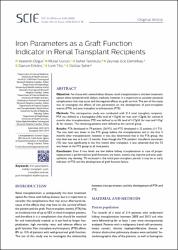| dc.contributor.author | Özgür, Yasemin | |
| dc.contributor.author | Gücün, Murat | |
| dc.contributor.author | Tanrıkulu, Seher | |
| dc.contributor.author | Demirbaş, Zeynep Ece | |
| dc.contributor.author | Erkılınç, Gamze | |
| dc.contributor.author | Titiz, Mesut İzzet | |
| dc.contributor.author | Şahin, Gülizar | |
| dc.date.accessioned | 2022-05-11T14:34:50Z | |
| dc.date.available | 2022-05-11T14:34:50Z | |
| dc.date.issued | 2019 | |
| dc.identifier.issn | 2587-0998 | |
| dc.identifier.issn | 2587-1404 | |
| dc.identifier.uri | https://doi.org/10.14744/scie.2018.26928 | |
| dc.identifier.uri | https://app.trdizin.gov.tr/makale/TXpRMU5EQTRPQT09 | |
| dc.identifier.uri | https://hdl.handle.net/20.500.11776/8113 | |
| dc.description.abstract | Objective: For those with severe kidney disease, renal transplantation is the best treatmentoption when compared with dialysis methods; however, it is important to consider potentialcomplications that may occur and the negative effects on graft survival. The aim of this studywas to investigate the effects of iron parameters on the development of post-transplantanemia (PTA) and post-transplant erythrocytosis (PTE).Methods: This retrospective study was conducted with 214 renal transplant recipients.PTA was defined as a hemoglobin (Hb) level of <13g/dL for men and <12g/dL for women 6months after transplantation, PTE was defined as an Hb level of >17g/dL for men and >15g/dL for women. The remaining patients were defined as the control group.Results: PTA developed in 79 patients (36.9%), and PTE developed in 25 patients (11.7%).The iron level was lower in the PTE group before the transplantation and in the first 3months after transplantation; however, it was also determined that in the PTA group, theiron level was low at 6 and 12 months. Even though the PTA patients’ transferrin saturation(TS) was rose significantly in the first month after transplant, it was observed that the TSwas lower in the PTE group at all time points.Conclusion: Even if iron levels are low before kidney transplantation in case of properreplecement is performed and graft functions are intact; anemia may improve and even polycythemia may develop. TS increased in the initial post-transplant period; it may be an earlyindicator of PTA and the development of graft function failure. | en_US |
| dc.description.abstract | Amaç: Böbrek nakli, diyaliz yöntemlerine kıyasla en iyi tedavi seçeneği olmakla birlikte sonrasında meydana gelen komplikasyonlar greft sağ kalımına olumsuz etkileri nedeniyle önemlidir. Bu çalışmanın amacı, demir parametrelerinin post transplant anemi (PTA) ve post transplant eritrositoz (PTE) gelişimi üzerine etkilerini araştırmaktır. Gereç ve Yöntem: Bu retrospektif çalışmamıza böbrek nakli yapılmış 214 hasta dahil edildi. Nakil sonrası altıncı aydan sonra bakılan hemoglobin düzeyleri ortalaması erkeklerde <13 g/dL, kadınlarda <12 g/dL olanlar PTA; yine hemoglobin düzeyleri erkeklerde >17 g/dL, kadınlarda ise >15 g/dL üstünde olan hastalar PTE; geri kalan tüm hastalar da kontrol grubu olarak tanımlandı. Bulgular: İki yüz on dört hastanın 79’unda (%36.9) PTA, 25’inde (%11.7) PTE geliştiği görüldü. Demir düzeylerinin nakil öncesinde ve nakil sonrası ilk üç ayda PTE grubunda düşük tespit edilmesine rağmen altıncı ve 12. ayda PTA grubunda düşüş gösterdiği tespit edildi. Transferrin satürasyonlarına (TS) ise nakil sonrası birinci ayda PTA grubunda anlamlı olarak yükselmesine rağmen, diğer tüm aylarda PTE hastalarında düşük seyrettiği tespit edildi. Sonuç: Böbrek nakli yapılmadan önce demir düzeyi düşük olsa dahi uygun replasman yapıldığı takdirde greft fonksiyonları sağlamsa eğer anemi düzelecek hatta polisitemi dahi gelişebilecektir. Nakil sonrası erken dönemde transferrin satürasyonları yükseliyorsa PTA’nın habercisi dolayısıyla greft fonksiyon bozukluğu gelişebileceğinin erken göstergesi olabilir. | en_US |
| dc.language.iso | eng | en_US |
| dc.identifier.doi | 10.14744/scie.2018.26928 | |
| dc.rights | info:eu-repo/semantics/openAccess | en_US |
| dc.title | Iron Parameters as a Graft Function Indicator in Renal Transplant Recipients | en_US |
| dc.title.alternative | Böbrek Nakli Olan Hastalarda Greft Fonksiyon Göstergesi Olarak Demir Parametreleri | en_US |
| dc.type | article | en_US |
| dc.relation.ispartof | Southern Clinics of Istanbul Eurasia | en_US |
| dc.department | Fakülteler, Tıp Fakültesi, Cerrahi Tıp Bilimleri Bölümü, Genel Cerrahi Ana Bilim Dalı | en_US |
| dc.identifier.volume | 30 | en_US |
| dc.identifier.issue | 1 | en_US |
| dc.identifier.startpage | 14 | en_US |
| dc.identifier.endpage | 19 | en_US |
| dc.institutionauthor | Titiz, Mesut İzzet | |
| dc.identifier.trdizinid | TXpRMU5EQTRPQT09 | en_US |



















